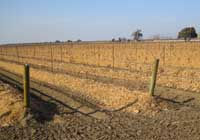|
Need an Expansion Loan? Better do the Prep
Growers looking for dollars to fund blueberry expansion programs, or who plan to plant the crop for the first time, are likely to be well received at many lending institutions these days, but they better go in with lots more than a handshake and a smile if they want a loan.
“Typically, what we look for … is not only a production plan but, more importantly, where will those berries go?” said Northwest Farm Credit Services (NFCS) regional VP Bob Boyle. “Who’s going to process those berries for you and how will they be marketed? And what is your ability over time to absorb the cost of those blueberry plantings and begin to recover cash needed to repay your investment?
 “It’s been a great couple of years for blueberry growers,” said Boyle, who also serves as the Oregon Blueberry Commission (OBC) public member. What concerns him is growers reacting to this by expanding and taking on more debt than they can handle, only to be in a world of hurt when markets cycle down. “Some people tend to expand too quickly and their focus is on short term profits.” “It’s been a great couple of years for blueberry growers,” said Boyle, who also serves as the Oregon Blueberry Commission (OBC) public member. What concerns him is growers reacting to this by expanding and taking on more debt than they can handle, only to be in a world of hurt when markets cycle down. “Some people tend to expand too quickly and their focus is on short term profits.”
Examples of this can be found in the nursery, grass seed, Christmas tree and dairy industries.
Boyle said that “What happens all too often, (growers) expand when things look really profitable, and as cyclical changes emerge find themselves tight on cash. That’s where a lot of producers get in trouble.”
Boyle said everything else being equal, a grower with good experience growing blueberries would have a leg up over new growers in the eyes of lenders as far as being successful with the crop.
That said, he hit again on marketing. “It’s the producer’s ability to really market that crop that often determines success of one over another. That’s particularly the case on your non-traditional products (like blueberries).”
Another thing knowledgeable lenders will look for, Boyle said, is what blueberry varieties are going in the ground, especially early and late varieties which are usually more profitable.
Boyle said that while consumer demand for blueberries continues to grow, the question is whether or not that demand will fully support new production coming online over the next three to five years.
Growers seeking loans, no matter the crop, should probably fare better with lenders like NFCS that are knowledgeable about agriculture. “We live it every day we’re in the office.”
While the Willamette Valley did not fully take part in the national upsurge in the ag economy from 2008 to 2010, Boyle said 2011 marked the rebound. “We’re seeing the front end of a really nice recovery here in ag as we go into 2012.”
If Boyle has a take-home message for growers, it’s that “The decisions you make in good times often set the stage for your ability to succeed when things get really, really tough.”
What’s important, he said, is crop diversity, rather than focusing on one crop one believes will dominate in the future.
|
Message from the Chairman
Packers Set to Enter South Korea on Fresh, New Note
Market Update -
Focus on Frozen
How Sawdust and Fertilizer Rates Impact Yields and Quality
Commission Booth a Hit at Oregon AgFest
New Pristine ® Supplemental Label Explained
Need an Expansion Loan? Better do the Prep
Beyer Goes to Bat for Blueberries in Salem
Blueberry Commission, Chefs Cook Up Joint Venture
Novel Chemical Applications for SWD Control
Assessment Hike Tabled by USHBC
Blueberry GAP Certifications Growing
Sign-Up for the USHBC Blueberry Alert System |

 “It’s been a great couple of years for blueberry growers,” said Boyle, who also serves as the Oregon Blueberry Commission (OBC) public member. What concerns him is growers reacting to this by expanding and taking on more debt than they can handle, only to be in a world of hurt when markets cycle down. “Some people tend to expand too quickly and their focus is on short term profits.”
“It’s been a great couple of years for blueberry growers,” said Boyle, who also serves as the Oregon Blueberry Commission (OBC) public member. What concerns him is growers reacting to this by expanding and taking on more debt than they can handle, only to be in a world of hurt when markets cycle down. “Some people tend to expand too quickly and their focus is on short term profits.”